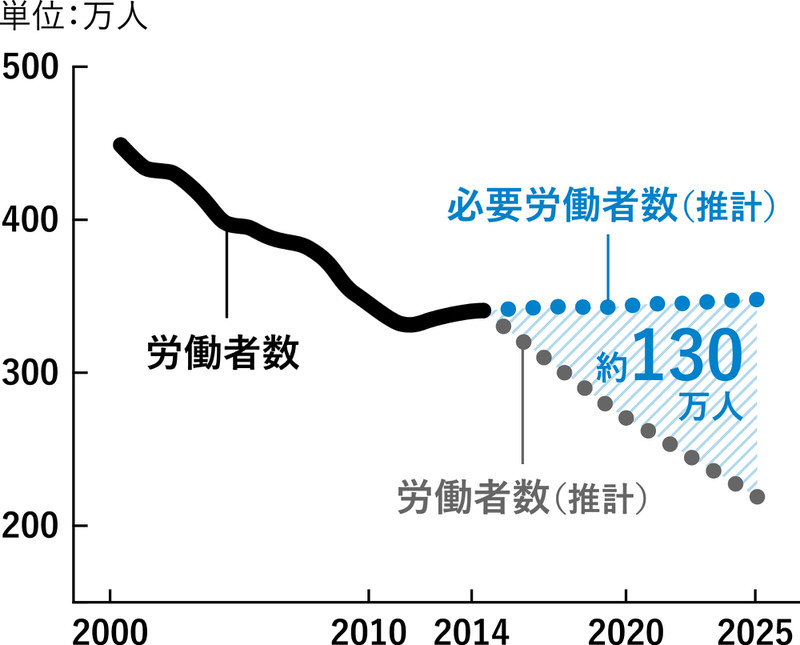A mismatch between supply and demand due to a shrinking labor force.
The construction industry in Japan is facing a crisis now.
Labor shortage due to rapid population decline.
(civil engineering and construction industries have become more serious)
Japan’s rapidly declining birth rate and aging population will lead to a decline in the labor force, and many industries are predicted to have labor shortages in the future. In particular, the shortage of workers in the construction industry is a serious problem, with the number of workers peaking at 6.85 million in 1997 and dropping to 5.03 million in 2018, a decrease of more than 25%. In addition, the aging of the workforce is a major challenge compared to other industries. Over the next decade, many of the people who have supported the field with their experience are expected to leave. This also means fewer highly skilled construction workers. According to one estimate, by 2025 there will be an estimated 1.3 million shortages of construction skilled workers.
建設技能労働者数の推移と推計

http://www.nikkenren.com/sougou/vision.html
より作成
The productivity of the civil engineering and construction industry, which is not rising, and the challenges
One of the characteristics of the civil engineering and construction industry is its relatively low productivity. The reasons for this lack of productivity compared to other industries are as follows.
Physical construction site characteristics
- Built to Order
- The same construction on the same terrain does not exist, and it always has to be tailor-made to meet different orders on different land.
- Local outdoor production
- It has to cope with various geographical and topographical conditions and ever-changing weather conditions.
- Labor-intensive production
- A lot of people have to go to the construction site.
Subdivision of labor
It is difficult to improve each construction production process (investigation/surveying → design → construction → inspection → maintenance and renewal) and each process (material procurement, parts procurement, various specialized works, etc.) because they are subdivided into different processes.
Small businesses and sole proprietors
Most of them are small and medium-sized enterprises (SMEs) and sole proprietors, and the hurdles to introducing advanced technologies are high, so the status quo tends to be maintained.
Work style reform that does not progress, young workers leaving the industry
With a shrinking workforce and low productivity, it cannot be said that the industry is making any progress in reforming its working methods. Working hours and annual workdays have not improved significantly, and the gap with other industries that are reforming tends to be larger. These are making it harder for young people to willingly choose construction as a job. Over the past few years, the number of new graduates entering the construction industry has hovered around 40,000, but that hasn’t been enough to fill the void left by those leaving the workforce. In addition, due to the nature of the industry, the number of women in the industry is not as high as it should be.

Urgent need to revitalize the industry to bridge the gap between supply and demand
The civil engineering and construction industry is facing the challenges of a declining workforce and low productivity, but that doesn’t mean the demand for it is going down. In addition to building new water, sewage, parks, and industrial roads that form the foundation of our lives, we must also continue to maintain and manage our aging facilities. In addition, in order to cope with natural disasters, which have become increasingly severe in recent years, land conservation work such as mountain control and flood control is also essential. We need to improve productivity and regain a vibrant construction industry that attracts more talent if we are to sustain people’s livelihoods into the future.


